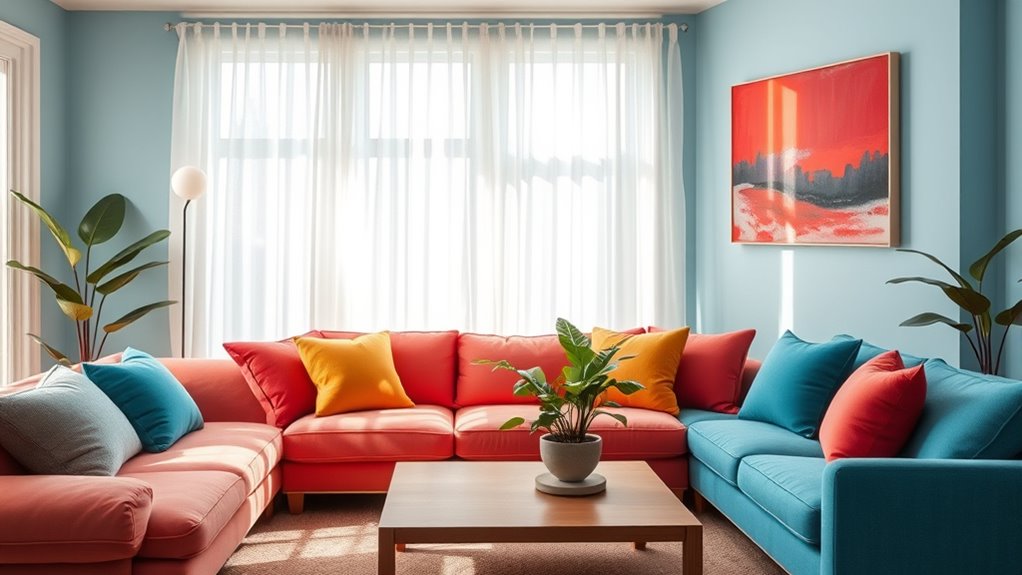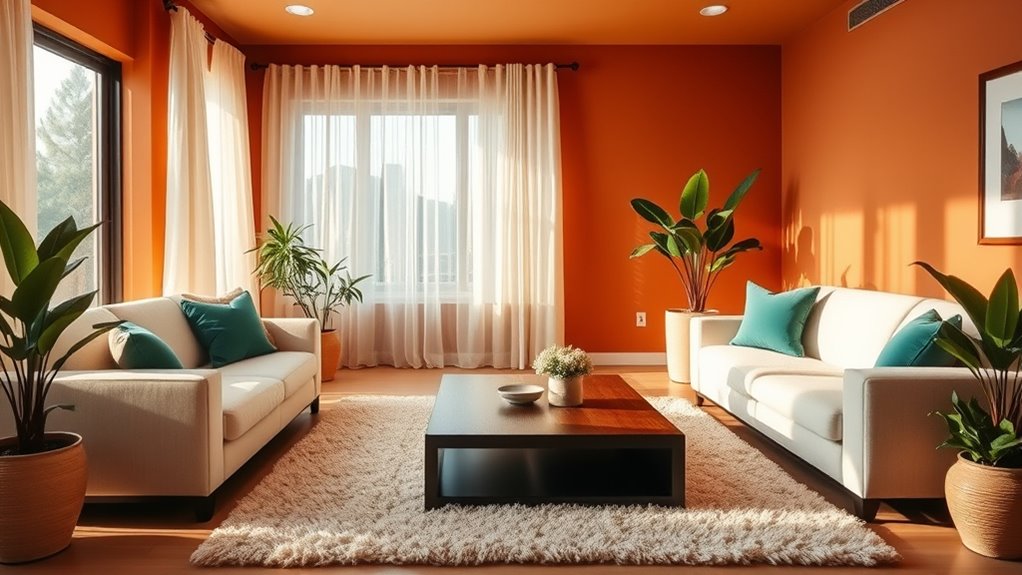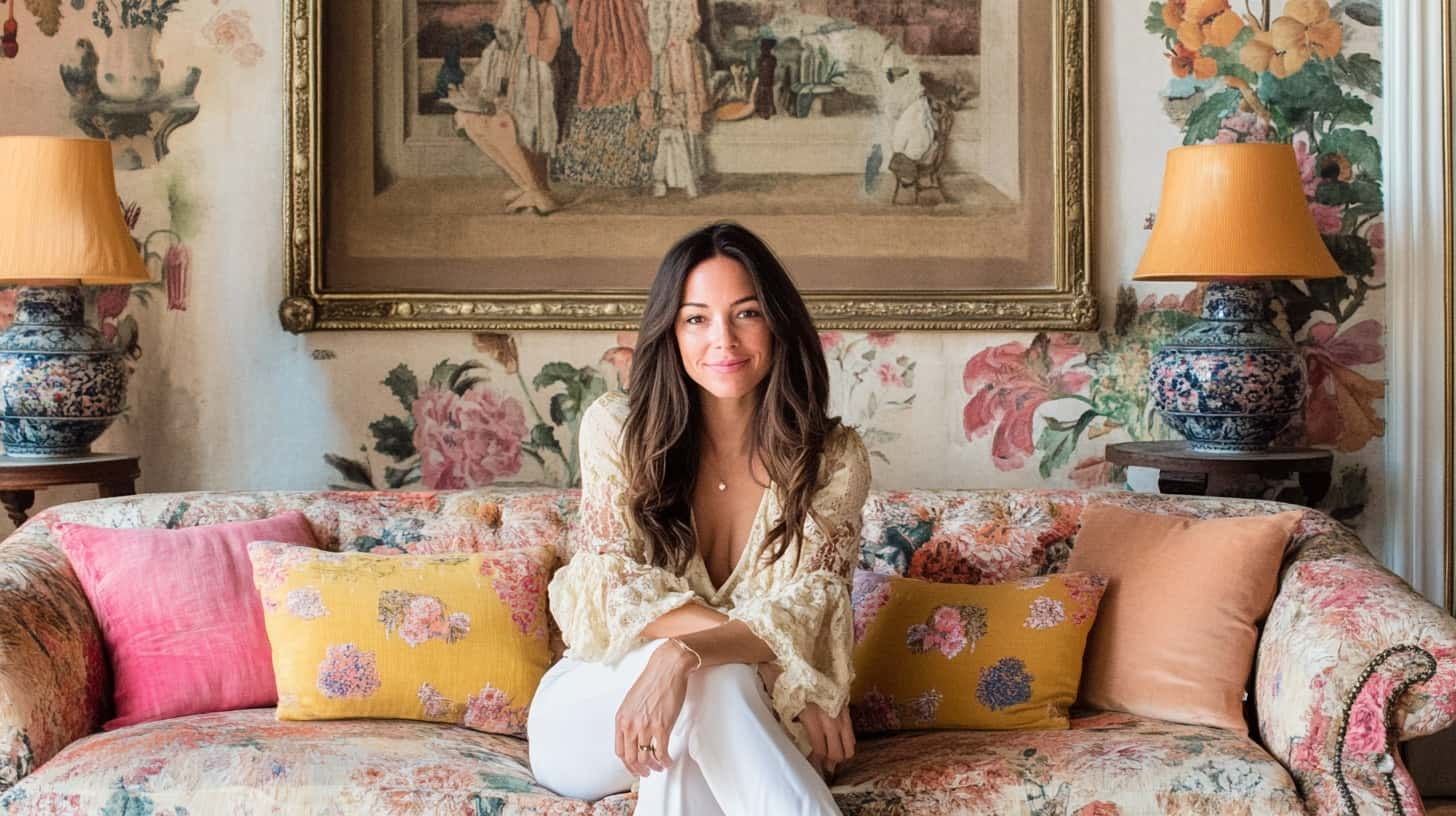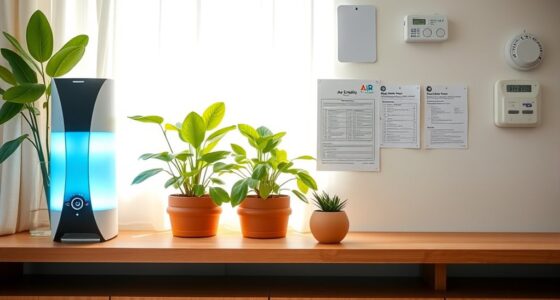Choosing the right color palette in interior design involves understanding how colors influence mood and behavior. Warm colors like red and orange energize, while cool shades like blue and green promote calmness and focus. Consider the function of each space and use color psychology to evoke the desired feelings. Balance bold or bright hues with neutral tones for harmony. To create inviting, balanced interiors, explore how different colors work together—more tips await if you continue exploring.
Key Takeaways
- Understand how warm colors energize and cool colors promote calm, aligning palette choices with the desired emotional atmosphere.
- Use the color wheel to select harmonious shades that balance warm and cool tones, creating cohesive spaces.
- Match colors to room functions—calming blues for bedrooms, energetic reds for activity areas—to support mood and purpose.
- Incorporate neutral tones to soften bold colors and enhance visual balance and versatility in interior spaces.
- Test color samples under different lighting conditions to ensure the palette evokes the intended emotional response.
Understanding the Emotional Impact of Colors

Colors have a powerful ability to influence your emotions and mood without you even realizing it. When you choose a color for a room, you’re not just picking a shade—you’re shaping how you feel inside that space. Warm colors like red and orange often energize you, boosting excitement and passion. Cool colors such as blue and green tend to promote calmness and relaxation, helping you unwind after a long day. Neutral tones like beige and gray create a sense of balance and stability. Recognizing how colors can evoke specific emotional responses allows you to design spaces that support your desired mood and well-being. By understanding these impacts, you can intentionally select hues that enhance your daily experiences and create a harmonious environment.
Popular Color Schemes and Their Psychological Effects

Choosing the right color scheme can considerably influence the mood and atmosphere of a space. For example, monochromatic schemes use different shades of a single color, creating harmony and simplicity. Complementary schemes pair colors opposite each other on the color wheel, adding vibrancy and energy. Analogous schemes feature neighboring colors, fostering a sense of unity and calm. Neutral palettes, with whites, grays, and beiges, promote versatility and relaxation. Warm color schemes, incorporating reds, oranges, and yellows, evoke energy, enthusiasm, and warmth. Cool schemes with blues, greens, and purples tend to be calming and soothing. Additionally, understanding the financial impact of color choices can help in designing spaces that appeal to specific audiences or serve particular purposes. Recognizing the safety considerations associated with various furnishings and materials ensures that aesthetic choices also meet safety standards. Incorporating cost-effective options can maximize the visual appeal without exceeding budget constraints. Choosing colors that align with lighting conditions can further enhance the ambiance and overall effectiveness of the design. Adapting color schemes to suit different textile types can further enhance the overall design. By understanding these popular schemes and their psychological effects, you can select a palette that best aligns with the mood you want to create in your space.
How to Use Color to Influence Mood and Behavior

Have you ever wondered how the colors in a space can subtly influence your emotions and behavior? Different colors evoke specific feelings and reactions. For example, blue promotes calmness and focus, making it ideal for workspaces or bedrooms. Red energizes and motivates, perfect for activity areas or gyms. Yellow sparks optimism and creativity, which works well in kitchens or playrooms. Green offers balance and tranquility, suitable for relaxation zones. When choosing colors, consider the mood you want to foster. Use bold hues to stimulate action or softer shades to encourage relaxation. Keep in mind that lighting and room size also affect how colors influence you. Additionally, understanding color psychology in interior design can help you select palettes that support your well-being and daily activities. Recognizing the impact of precious metals in retirement planning can further inform your financial decisions. Being aware of how caffeine content in espresso varies can help you manage your consumption effectively. By intentionally selecting colors based on desired emotional outcomes, you can create spaces that support your well-being and daily activities. Incorporating principles of space maximization and organization can enhance the functional benefits of your color choices, creating a harmonious and efficient environment. Exploring dog names can also add a personalized touch to your home environment, reflecting character and style.
Tips for Selecting the Perfect Palette for Different Spaces

Selecting the right color palette for a space involves understanding its purpose and the mood you want to create. For a calming bedroom, opt for soft, muted tones like blues or pastels that promote relaxation. In a lively kitchen or playroom, choose bright, energetic colors such as yellows or oranges to boost activity and enthusiasm. For professional spaces like offices, stick to neutral shades like grays or beiges that foster focus and productivity. Consider the natural light; rooms with ample sunlight can handle darker or richer hues, while darker spaces benefit from lighter shades to brighten the area. Additionally, understanding the impact of contrast ratio on visual clarity can help you select colors that enhance the overall image quality and user experience. Being aware of local regulations and regional resources can also guide you in choosing sustainable and compliant color schemes. Incorporating color harmony principles can further ensure that your palette feels cohesive and balanced. Developing a creative practice can also help you experiment with different color schemes and find what resonates best with your space. Also, exploring remote hackathons can provide innovative ideas and new perspectives on design challenges.
Combining Colors for a Harmonious Interior

To create a harmonious interior, you need to understand how colors work together on the wheel and choose compatible shades. Balancing warm and cool tones adds depth and interest, while smartly using accent colors can highlight features. Additionally, considering the security of digital tools used in interior design, such as smart home systems, can enhance both safety and convenience. Incorporating privacy policies and understanding cookie management helps ensure that your digital environment remains secure and respects user preferences. Being aware of sound design principles, even in interior spaces, can also contribute to a balanced and inviting atmosphere. Understanding Cultural Intelligence can help in selecting colors that resonate well across diverse cultural backgrounds, making your space more inclusive. Integrating color psychology insights can further influence mood and perception within your space, making it more inviting and personalized. By mastering these techniques, you’ll craft a space that feels both cohesive and inviting.
Color Wheel Compatibility
Understanding color wheel compatibility is essential for creating a harmonious interior. The color wheel helps you identify which hues work well together, making your space feel balanced and visually pleasing. Complementary colors, found opposite each other on the wheel, create vibrant contrasts that energize a room. Analogous colors, side by side on the wheel, produce a cohesive and calming effect, perfect for relaxing spaces. Triadic combinations, evenly spaced around the wheel, offer vibrant harmony without overwhelming. When choosing colors, consider the wheel’s relationships to ensure your palette feels unified. Avoid clashing hues by respecting these compatibilities, and remember that adjusting saturation and brightness can further refine your color harmony. Proper use of the color wheel ensures your interior feels intentional, balanced, and inviting. Additionally, understanding color harmony principles can help you create a more cohesive and aesthetically pleasing design.
Balancing Warm and Cool Tones
Balancing warm and cool tones is essential for creating a space that feels both lively and calming. You want to avoid an overly energetic room or one that feels cold and uninviting. To achieve harmony, mix warm shades like reds, oranges, and yellows with cool hues such as blues, greens, and purples. Use the following table to guide your choices:
| Warm Tones | Cool Tones |
|---|---|
| Red, Orange, Yellow | Blue, Green, Purple |
| Bring energy and warmth | Add tranquility and depth |
| Use as accent or main | Balance with warm accents |
| Combine for contrast | Create visual interest |
| Pair with neutral shades | Soften bold colors |
Additionally, incorporating Free Floating elements can help to seamlessly blend these tones and create a cohesive look throughout your interior.
Using Accent Colors Effectively
Incorporating accent colors is a powerful way to enhance harmony and visual interest in your interior. To do this effectively, choose a bold or contrasting hue that complements your main palette. Use accent colors in small but impactful ways, like throw pillows, artwork, or decorative accessories. Keep the balance in mind—avoid overwhelming the space with too many bright accents. Instead, select one or two key colors to create focal points. Consider the mood you want to evoke; warm accents can energize, while cool tones add calm. Pay attention to the placement of your accents, ensuring they highlight architectural features or draw your eye to specific areas. When used thoughtfully, accent colors tie your room together and express your personal style. Exploring color psychology can help you choose hues that align with the desired emotional effect. Additionally, understanding visual harmony principles ensures your color combinations create a cohesive and pleasing environment. Incorporating wall organization systems with your accents can further enhance the overall aesthetic and functionality of your space.
Practical Considerations When Choosing Colors for Your Home

When selecting colors for your home, consider how lighting affects their appearance throughout the day. Think about the room’s purpose and the mood you want to create, as colors can influence feelings and behavior. Balancing these factors helps you choose shades that look great and support your lifestyle. Additionally, understanding color psychology can guide you in selecting hues that promote comfort and positivity in your space. Exploring generative AI in media and entertainment can also provide creative inspiration for choosing color schemes that resonate with your personal style. Incorporating self watering plant pots can also enhance your interior environment by maintaining healthy plants that contribute to a calming atmosphere.
Lighting Impact on Colors
Have you ever noticed how a room’s colors can look dramatically different under various lighting conditions? Natural daylight reveals true hues, making colors appear brighter and more vibrant. In contrast, warm incandescent lighting softens shades, giving them a cozy, amber tone. Cool fluorescent lighting can mute colors or make them look dull. When choosing your palette, consider the lighting in each room throughout the day. Test paint samples in different lighting to see how they change. Also, think about the type of bulbs you’ll use—warm or cool—to guarantee your colors stay true to your vision. Remember, lighting doesn’t just illuminate; it transforms color perception, so plan accordingly to create the ambiance you desire.
Room Function and Mood
Choosing colors for each room depends largely on its function and the mood you want to create. For a relaxing bedroom, soft blues or gentle neutrals promote calmness and serenity, helping you unwind. In a lively kitchen or dining area, warm tones like yellows or oranges can stimulate energy and conversation. Home offices benefit from colors that boost focus, such as muted greens or balanced neutrals. Living rooms, where socializing occurs, often work well with inviting shades like warm beiges or subtle terracottas. Consider the activities happening in each space and select colors that enhance those experiences. Remember, the right color palette can influence emotions and functionality, making your home more comfortable and aligned with your lifestyle.
Frequently Asked Questions
How Do Lighting Conditions Affect Color Perception in Interior Design?
Lighting conditions greatly influence how you perceive colors in your space. Natural light makes colors appear brighter and more vibrant, while artificial lighting can dull or warm tones. You should consider the type and placement of your lighting fixtures, as well as the time of day, to guarantee your chosen colors look their best. Adjusting lighting can help you achieve the mood and ambiance you want in your interior.
Can Color Psychology Influence Productivity in Home Offices?
Yes, color psychology can boost your productivity in home offices. Bright, energizing colors like blue or green can help you stay focused and calm, while warm tones like yellow may inspire creativity. By choosing the right colors, you create an environment that encourages efficiency and reduces stress. You’ll find that your mood and work output improve simply by selecting hues that align with your goals and personal preferences.
What Cultural Differences Should Be Considered in Color Choices?
When choosing colors for your space, you should consider cultural differences because colors hold varied meanings worldwide. For example, white symbolizes purity in Western cultures but can represent mourning in some Asian countries. Red is lucky in China but may evoke warning in Western contexts. Being aware of these differences helps you select colors that respect cultural significance, creating a welcoming and appropriate environment for everyone.
How Do Trends Impact Long-Term Color Palette Selections?
Think of trends as waves in the ocean—you ride them, but they eventually recede. When selecting long-term color palettes, you should consider current trends carefully, as they influence popular tastes. However, don’t rely solely on fleeting fads; instead, blend timeless colors with trend-inspired accents. This approach guarantees your space remains stylish yet enduring, giving you a balanced design that adapts over time, much like a well-crafted sailboat steering changing tides.
Are There Eco-Friendly or Non-Toxic Paint Options for Color Application?
You’ll find plenty of eco-friendly and non-toxic paint options available today. Look for brands that offer low or zero-VOC paints, which release fewer fumes and chemicals. You can also choose paints made from natural ingredients like clay, milk protein, or plant-based dyes. By selecting these options, you create a healthier indoor environment for yourself and your loved ones while still achieving your desired color and style.
Conclusion
By understanding color psychology, you can create spaces that truly reflect your mood and personality. Did you know that color can influence your emotions and even increase productivity? Choosing the right palette isn’t just about aesthetics—it’s about shaping how you feel in your home. So, experiment with different schemes and trust your instincts. With a little insight, you’ll craft an environment that’s both beautiful and emotionally uplifting.










